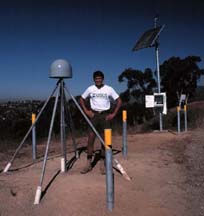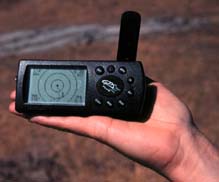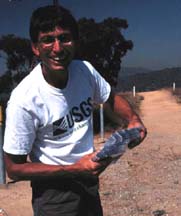
John Galetzka at a GPS Supermonument.
Click on the image for an enlarged view.
Occidental College is located on a hill between Glendale and Pasadena. Near the top of the hill there was a strange sculpture, perched on top of one vertical pole and four widely spread poles was a dome about 6 feet above the ground, it looked like a lander from another planet. John Galetzka was the coordinator for a network of 250 of these "monuments." He joined me and the Exploratorium Live@ crew at the monument to explain what the monuments stood for.

The monument was a GPS, Global Positioning System, receiver. The monument was designed to anchor the antenna firmly to the bedrock. The strange pentapod, which is sometimes called a half-spider, was made of stainless steel filled with concrete. The legs were drilled 30 feet (10m) into the ground. John said that they were built to last many decades, perhaps hundreds of years. The antenna was attached to a GPS receiver and a data storage and transmission unit. Every 30 seconds the unit recorded its position good to within the volume of a fist, a radius of 10 cm, it then transmitted its position to JPL. At the end of each day these positions were averaged to give the location good to within a few millimeters, the size of a pea. Over years of observation, the position can be refined to smaller than a BB, and the motion can be found too, this particular station is moving northwestward at 30 mm (about an inch) per year relative to the North American plate.

I pulled out my GPS receiver, it could tell me where I was to within the volume of a domed football stadium. But I could hold it in my hand, and it cost less than $300. John told me that they used the well-known positions of these monuments to calibrate the GPS system. By knowing the positions of these monuments, they could tell where the GPS satellites were and thus correct our knowledge of their orbits. Which helped me in turn to find out where I was. They planned on having the monuments survive for a hundred years.
Around us, the beautiful view of LA was disappearing in the thickening smog as the ultraviolet light from the sun reacted with emissions from factories and cars. The smog was trapped by surrounding mountains. The mountains were built by the collision of the Pacific plate and the North American plate. Most people think of the San Andreas as a single line along which the plates slide past one another. But the San Andreas fault is not a straight line, it bends from side to side. When it bends to the left, the edges of the fault are compressed together building mountains, when the fault bends to the right the sides pull apart creating depressions which become sag ponds..
John added that the boundary between the plates is complex, made of many faults, only one of which is the San Andreas. The relative motion of the plates is spread across a width of 60 miles (100 km). Thus there is a San Andreas Fault "system." The fault system we were following.
John Galetzka's activities:
The response of the layers in the earth to compressive forces can be illustrated with a phonebook. The pages in the book are flat like recently deposited sedimentary layers in the earth. Hold the phonebook level with the spine in one hand. Push the book together with the other hand. Under compression the book will begin to fold. Just like the sediments in the LA basin. the folds arch upward in an anticline and downward in a syncline. The mountains around LA are the result of similar compressional forces.

John showed how the motion between two plates is spread across a wide region. He grabbed a dozen compact disk jewel boxes, and held them between his hands like an accordion. He then slid one hand forward and the other hand back. The motion of his hands was shared among the cases. This is how the motion of the two plates is shared across many faults in the San Andreas system.
Visit the Exploratorium web pages for more information on faults:
Go to the Exploratorium Faultline Website.
|
Scientific Explorations with Paul Doherty |
|
11 Oct 99 |